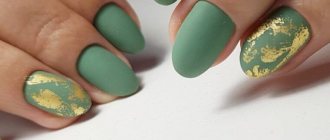There is very little time left before the summer season begins, which means you should think about acquiring an even, dark golden tan and protecting your skin during a beach holiday. The modern tanning cosmetics market offers a wide range of creams, lotions and gels, the action of which is aimed at protecting the skin from drying out and protecting it from negative ultraviolet radiation. However, few people know that a similar effect can be achieved by using coconut oil for tanning.
Coconut oil and its properties
Coconut oil is a liquid obtained from the flesh of the coconut, called copra. There are several types of this herbal product. Depending on the extraction method, coconut oil can be obtained either by hot extraction or by cold pressing. The second option for obtaining oil is more preferable, because it retains more beneficial properties.
Also, depending on the degree of processing, coconut oil can be unrefined, that is, it is not subjected to strong filtration and retains its original color and sweetish smell; it is mainly used in cooking.
And accordingly, there is a refined type of coconut oil, in which after several stages of purification, it becomes snow-white and practically odorless. This oil is used in cosmetology.
Coconut oil is a unique product that provides benefits both internally and externally. By consuming coconut oil, you can cure some diseases of the gastrointestinal tract, improve brain function, and strengthen the immune system.
This positive effect for many body systems is due to the fact that coconut oil contains unique omega acids (oleic, linolenic) and polyunsaturated fatty acids (caprylic, lauric, myristic, etc.), which the body is not able to reproduce on its own.
Coconut oil also contains useful microelements - calcium, phosphorus, iron and zinc and some vitamins - C, E, A, K. Coconut oil also contains hyaluronic acid, phytostyrols and antioxidants. Thanks to such a composition rich in useful substances, coconut oil is actively used as a skin care product to give smoothness and vitality to hair, reducing its fragility and loss.
Recipes for getting a beautiful and even tan
A protective reaction to ultraviolet irradiation is the production of the pigment melanin, which gives the skin a dark tint.
However, there is a high risk of sunburn; after prolonged exposure to sunlight, pigmentation disorders (vitiligo, melasma) may occur, and the skin undergoes photoaging. To reduce the negative effects of the summer sun, various protective agents are used, including fatty substances from coconut palms.
Coconut oil for tanning can be used both in its pure form and as part of various factory-made or independently prepared complex mixtures. As a rule, it is recommended to use a cold-pressed product in its pure form - as it is more valuable and rich in nutrients. Whereas raw materials obtained as a result of hot pressing (very often mistakenly called “unrefined”) are better used in combination with other components.
Cold pressed oil
This product is more expensive, but also more valuable. It is best to store it in the refrigerator, where it is kept solid. When placed in a warm environment (25–27 C), the product melts and turns into a transparent yellow liquid.
The oil is applied in its pure form before going out into the sun. To do this, the skin is first lightly washed with water and mild soap and after drying, oil is applied, and it is almost immediately and completely absorbed into the skin, making it smooth and pleasant to the touch. It provides long-lasting hydration and uniform distribution of pigment, and also protects the epidermis from free radicals. However, cold-pressed oil only slightly blocks ultraviolet rays, so it cannot be used as a complete alternative to sunscreen. It is possible to prepare a mixture of one third oil and two thirds of a special product to protect the skin from ultraviolet radiation.
Similarly, you can use coconut oil for tanning not only under natural ultraviolet rays, but also before visiting a solarium. This ensures faster and more uniform darkening of the skin and reduces the likelihood of developing side effects from artificial ultraviolet irradiation.
Hot pressed oil
This product contains a reduced amount of healthy fatty acids. In addition, oxidation products can be found in it, which prevent the product from effectively penetrating into the layers of the skin. For this reason, “unrefined” coconut oil is best used as part of multi-ingredient products to protect the skin from the sun and obtain a beautiful shade. Here is a recipe for such a homemade remedy:
- 100 g hot-pressed coconut oil;
- 100 g shea butter;
- 50 g jojoba oil;
- 2 tbsp. l. beeswax granules;
- 1 tbsp. l. zinc oxide powder;
- 1 tsp each carrot and red raspberry seed oils.
All these components can be easily purchased at any professional cosmetics store or website. The preparation of protective cream occurs in several stages:
- First, coconut, shea butter, jojoba oil and beeswax are melted together in a water bath.
- After obtaining a homogeneous mixture, it is allowed to cool to room temperature and zinc oxide is added, which provides the protective and disinfecting properties of the mixture. The resulting mass is thoroughly mixed and placed in the refrigerator for a quarter of an hour.
- Then add carrot and raspberry oils to the mixture and begin to beat with a mixer until a light and airy cream is obtained. The latter components provide high protection of the entire mixture from ultraviolet radiation.
The resulting cream is stored in the refrigerator in glass or enamel containers. It is used in the same way as any other sunscreen - applied to the skin before going out into the sun or getting a tan.
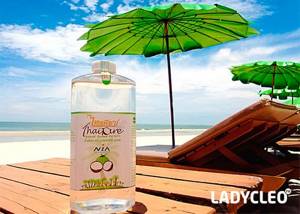
Benefits of coconut oil for skin and tanning

Coconut oil is a universal product, the range of beneficial properties of which is excellent for caring for the skin of the body and face. It moisturizes and nourishes the epidermis, making it firm and elastic. Coconut oil has excellent antiseptic properties, can soften and heal the skin, and is also used as an anti-aging agent.
Due to its dense consistency and ability to retain moisture inside skin cells, coconut oil is often used during sunbathing. It is well absorbed and does not print on clothes. When tanning, using coconut oil provides the following benefits:
- saturation of the skin with natural nutrients;
- prevents dryness, redness and death of the top layer of skin;
- provides additional skin protection from the negative effects of ultraviolet radiation;
- provides additional protection for the skin from burns;
- prevents premature aging and loss of skin elasticity under sun exposure;
- promotes uniform tanning, as when using coconut oil, the surface of the skin smoothes out and becomes soft and elastic.
Coconut oil after sunbathing
After prolonged exposure to the sun, the skin rapidly loses moisture; under the influence of ultraviolet radiation, a large number of free radicals are formed in the dermis, damaging collagen fibers and skin tissue. Such processes develop even in the absence of external manifestations of sunburn. Therefore, applying coconut oil or coconut-based tonics after sunbathing will help the skin recover faster and reduce free radical damage. This will also significantly reduce the risk of developing photoaging and pigmentary disorders.
It is especially useful to use this product if your skin is sunburned. In such a situation, tissue disorders are also accompanied by vascular ones, redness, pain occur, and in some cases, a deterioration in the general condition. Such a remedy can significantly ease the victim’s well-being and will help quickly eliminate unpleasant symptoms.
Features of using coconut oil while tanning in the sun and in a solarium

There is a list of simple rules to increase the effectiveness of using coconut oil in the process of tanning in natural conditions:
- Before visiting the beach and using the oil, you need to lightly exfoliate your body and face. This procedure must be done once, since during the process of tanning the skin, the use of peeling and scrub is not allowed.
- Before going directly to the beach, you should take a shower and apply coconut oil to clean skin. You should not use the oil on the beach itself, as sand will stick to your skin and interfere with your tan's uniformity.
- If your stay on the beach lasts for more than two hours, or after swimming in a pond, you need to reapply the oil to the skin of your body and face. In this case, it is better to first degrease the skin with lotion and then rub in the oil.
- Coconut oil's SPF level is eight, which is insufficient for UV protection. Therefore, on top of the layer of coconut oil, it is necessary to apply a sunscreen with an SPF value of at least twenty-five. Or you can mix both products for better skin protection and hydration.
- After returning from the beach, you need to take a shower and apply coconut oil as a moisturizer and nourisher.
- To get a beautiful bronze skin tone and maintain a tan for a long time, apply the oil before bed.
Coconut oil is also suitable for use when visiting a solarium, and in this case the rules for its use are practically no different from use outdoors:
- Before visiting the solarium, it is recommended to take a shower and apply oil.
- An hour after the end of the insolation session, the oil must be reapplied to the skin.
- After tanning in a solarium, you should not take a shower immediately; it is better to do this after three hours.
- Also, to protect your skin from drying out, you should apply coconut oil before going to bed.
Natural remedy for a beautiful tan
Coconut oil, among other beneficial qualities, can be used to obtain a sustainable and safe tan. This natural product allows you not only to tan beautifully, but also to reliably protect your skin from the effects of scorching sun rays.
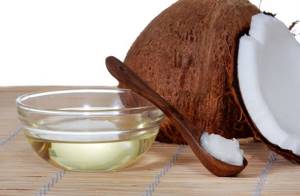
Coconut oil is the best “treat” for the skin
Since ancient times, the exotic beauties of Polynesia were famous for their tanned bronze skin. The secret of dark-skinned beauties was simple - the girls rubbed themselves from head to toe with a natural remedy at hand - coconut pulp, which, as is known, contains up to 65 percent of the famous natural oil that promotes a beautiful tan.

Asian girls know the secrets of a perfect tan
Benefits of coconut oil
The high content of valuable fatty acids in coconut oil makes this natural remedy unique for gentle skin care. Here's how coconut oil affects the skin:
- deeply moisturizes and helps retain moisture;
- nourishes tissues and activates metabolic processes;
- stimulates rapid melanin synthesis;
- helps preserve vitamin D;
- keeps the skin smooth, tightened and gives it a radiant appearance;
- prevents skin aging under the influence of sunlight;
- protects against burns;
- protects against the aggressive influence of natural factors (ultraviolet radiation, sea salt, etc.).
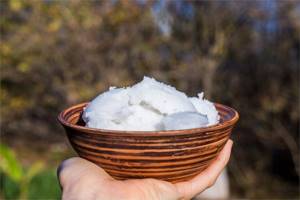
Coconut oil will reliably protect your skin from the sun
How it works
The main active ingredients of coconut oil are biologically active fatty acids, which are presented in a large assortment in the product:
- lauric - has powerful anti-inflammatory, rejuvenating and protective properties;
- palmitic - responsible for tissue renewal at the cellular level and collagen production;
- oleic - promotes prolonged skin hydration by retaining water in the dermis;
- stearic – increases the level of “self-defense” of the body, prevents early aging;
- folic - heals and quickly restores superficial damage;
- caprylic - stimulates metabolic and recovery processes.
Coconut oil itself already has a high ultraviolet filter index - spf 8, and when applied over sunscreen (as recommended by experts), the drug gives excellent results. At the same time as protecting against sunburn and other negativity, natural coconut oil takes on the important role of a tanning activator - that is, it guarantees not only its safety, but also a deep, even tone.

Coconut oil gives the skin everything it needs
Coconut gives your skin exactly what it needs. And coconut oil, which does not contain harmful chemical additives, is the most common and reliable natural remedy for optimal tanning.
Ways to use coconut oil - video
Coconut Oil Tanning Recipes
For adherents of the use of natural skin care products, we can recommend the following recipes for tanning products with coconut oil:
Simple cream
To prepare this cream, mix one tablespoon of coconut oil with three tablespoons of sunscreen.
Apply twenty minutes before going to the beach. You can prepare a supply of this product for use on the beach. However, when outdoors, you should store the container with this cream in your beach bag to avoid direct sunlight on the product.
Shea cream
Melt one tablespoon each of coconut oil and shea butter in a microwave oven, add two tablespoons of vegetable oil, mix well. Apply at least fifteen minutes before going to the beach.
Oil lotion
To prepare such a lotion, you need to take one hundred milliliters of sunflower or olive oil and heat it in a microwave oven.
Then add 1 teaspoon each of coconut and shea butter to the heated oil. Stir until the harder oils are completely melted, then add one ampoule of liquid vitamin E. This lotion must be shaken well before each use. If the lotion has separated as a result of storage, you can warm up the composition and shake it. Apply at least fifteen minutes before going to the beach.
Tanning cocktails with essential oils
- mix two tablespoons of coconut oil with one tablespoon of grape seed oil, add four drops of any citrus essential oil (except lemon, as it has a brightening effect);
- mix one tablespoon of coconut oil with one teaspoon of peach oil, add five drops each of jojoba oil and almond oil;
- mix two tablespoons of coconut oil with one tablespoon of olive oil, add eight drops of ylang-ylang essential oil.
These cocktails should be applied in the morning after a shower, followed by sunscreen. To enhance the effect, you can use such compositions after an evening shower.
How to use
Coconut oil is extremely convenient to use. Using this tanning product, you usually don’t even have to melt it, because the air temperature on the beach most often exceeds 25 degrees, at which point the solid unrefined oil begins to soften on its own and turns into a liquid state. If this process requires acceleration, you can simply rub a piece of butter between your palms or hold it under running warm water - and it will quickly melt.

A light massage will enhance the effect of coconut oil
Most often, coconut oil is used on the skin for tanning in its pure form, somewhat less often - in combination with professional UV protectors or in a mixture with other base oils.
In the sun
During your stay at sea, especially in the first days, it is recommended to combine the use of coconut oil and specialized ultraviolet protection products. This approach will ensure that only safe sun rays are attracted to the skin and the result is a beautiful caramel tan without redness, peeling and other troubles.

The sun protection power of coconut is ideal for use on the beach
The nuances of how exactly to use coconut oil for natural tanning depend on the individual characteristics of the skin, in particular, on the degree of its sensitivity to the sun. There are general rules for using this effective natural remedy, compliance with which gives stable positive results.
- Before going to the beach, you need to cleanse your body of dirt and sweat - protective products should be applied only to clean skin; It is enough to take a shower with warm fresh water, without soap, but in this case you should not use a scrub.
- It is advisable to carry out water procedures in advance, an hour and a half before the planned sunbathing - first the shower should be warm or even hot, and at the end you should definitely rinse with cool water, which will help narrow the pores.
- After a shower, you should not actively rub your skin until it turns red - just pat it lightly with a soft towel, and apply unrefined coconut oil to the still damp body with smooth massage movements, after melting it with the warmth of your palms.
- To allow the oil and moisture to be absorbed well, it is recommended to walk around the room without clothes for an hour, without going to bed, and, if possible, without sitting down - after which you can put on a swimsuit and get ready for the beach.
- Already directly on the seashore, you can apply the finished sunscreen to the body - it is important to distribute the cream in an even thin layer over the entire surface of the skin, without missing even small areas.
- Do not overexpose yourself to direct sunlight - try to limit your first tanning session to two, or maximum three, morning hours, so that you are back from the beach by eleven in the morning.
- Gradually increase the time spent in active sun; If you swim in the sea, renew the protective layer of coconut oil on your body, refreshing it every half hour.
- An hour and a half after returning from the beach, rinse your body again with warm running water and soft shower gel and, if possible, lie down relaxed for at least half an hour - the room should not be too hot and stuffy.
- If desired, after a shower, you can use coconut oil again - this is very useful for maintaining skin moisture and preventing inflammation in certain areas.
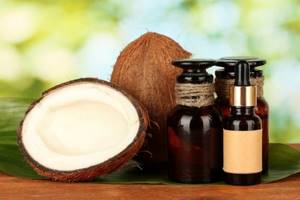
Coconut oil - health and beauty of your skin
An effective protective mix
A mixture of healthy oils guarantees the skin triple protection from ultraviolet radiation and a spectacular tan.
Ingredients:
- shea butter and coconut butter - 1 tablespoon each;
- olive oil - 3 tablespoons.
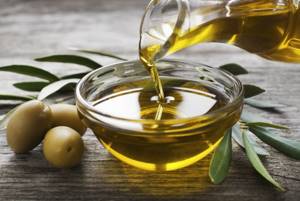
Olive oil is an excellent homemade tanning base.
Application:
- Combine all the components of the mixture in one container and place it in a water bath.
- Heat the mixture, stirring, over low heat until the pieces of coconut oil and shea melt, do not overheat, much less bring to a boil.
- Cool the finished product and apply it to the skin 15 minutes before you start sunbathing so that the oil has time to be absorbed.
Vitamin spray
The protective oil spray bottle is very convenient to use on the beach; By using a mixture of oils and vitamins, you will get quick and impressive results.
Ingredients:
- shea butter and coconut butter - 1 tablespoon each;
- castor oil - 0.5 cups;
- vitamins A and E - 1 capsule each.

Vitamins A and E - first aid for your skin
Application:
- Heat the shea and coconut oils to about 30 degrees and pour the mixture into a spray bottle.
- Add castor oil there, cap the bottle and shake thoroughly.
- Shake the mixture every time before applying to the skin.
Natural sunscreen recipe - video
In the solarium
Recommendations for using coconut oil for artificial tanning in a solarium have their own specifics. Use them to achieve the best results.
- Two hours before going to the solarium, take a warm shower, generously rinsing and massaging your body with streams of running water; You can do without detergents this time.
- Lightly pat your skin dry with a terry towel and immediately apply melted coconut oil to your skin.
- While the oil is absorbed, prepare a mixture of coconut oil and suntan lotion - combine them in equal proportions and mix thoroughly until smooth.
- Exposed areas of the body will need to be evenly lubricated with this mixture already in the solarium, a few minutes before the start of the procedure.
- At the end of your tanning session, you can apply a small additional portion of coconut oil to your skin - this time in its pure, undiluted form.
- Do not take a second shower immediately after tanning - at least two hours should pass after the procedure.

When sunbathing in a solarium, be sure to protect your skin
Staying in a solarium is characterized by a higher intensity of ultraviolet radiation than when tanning in natural conditions. Here it is appropriate to use protective agents of increased effectiveness, diluting professional tanning creams with coconut oil. In this case, soft oil mixtures will not give a good result.
During pregnancy
If the doctor observing you believes that moderate sun and sea baths will not harm you during pregnancy, do not deprive yourself of this pleasure. And be sure to use coconut oil - it will protect your skin from any troubles associated with tanning and more. Coconut oil is safe for the expectant mother and her baby.

Sunbathing during pregnancy - don't forget to use coconut oil
A pleasant bonus will be the prevention of stretch marks, which so often upset women when they appear during pregnancy. By the way, coconut oil will also help even out the tan tone on areas of the skin with long-standing stretch marks, which have not yet been gotten rid of.
For children
Children's delicate skin needs special protection from the sun. A child is more likely than an adult to get burns, allergies, and other dangerous side effects of tanning. But I don’t really want to use synthetic protective drugs for my baby. In this case, coconut oil is ideal - natural, reliable and safe. Well, of course, you shouldn’t forget about the rules for children staying in the open sun either.

Coconut oil is an excellent sun protection for children
Use after sunbathing and sunburn
If you only used a commercially produced cosmetic sunscreen while tanning on the beach, then coconut oil can be applied after returning from the beach. This approach will allow you to well moisturize, nourish and ensure a uniform skin tone, make it elastic, which will help extend the life of your tan. To achieve this effect, coconut oil must be applied after a shower to damp skin, with light rubbing movements, daily.

If you get a sunburn while tanning, you can prepare home remedies based on coconut oil, as it has an anti-inflammatory, soothing and regenerating effect. The following masks are good for treating sunburn:
- Mix sour cream (kefir, natural yogurt) and coconut oil in equal proportions. Apply to the burned area, rinse after twenty minutes with cool water. The amount of mask ingredients depends on the area of the affected area.
- Mix coconut oil and heavy cream in equal proportions, add a few drops of wheat germ essential oil. Apply the mask to the problem area, after fifteen minutes, rinse with cool water.
- Mix aloe juice and drinking water in equal proportions, add two to three teaspoons of coconut oil. Do not rinse off.
- Mix coconut oil with panthenol-based pharmaceutical product in a ratio of 1:3. Do not rinse off.
- To one to three tablespoons of coconut oil (depending on the size of the burned area), add four to eight drops of tea tree essential oil and two to four drops of rosehip essential oil. Do not rinse off.
- Mix one to two tablespoons of coconut oil and glycerin, add one teaspoon of chamomile essential oil. Do not rinse off.
After using masks and cleansing the skin, it is best to apply pure coconut oil or any pharmaceutical remedy for burns.
Indications and contraindications
Indications:
- dry skin;
- loss of firmness and elasticity;
- signs of withering and early aging;
- desire to get a lasting, even tan.
Contraindications:
- use during periods of high solar activity (you can get burns);
- individual allergic skin reactions.

How to choose quality coconut oil
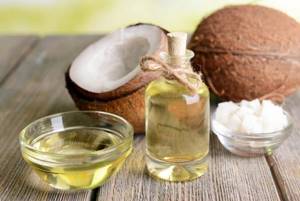
When choosing coconut oil, you should pay attention to the following:
- manufacturer's fame;
- purchasing in a store rather than in souvenir stalls;
- a mark on the expiration date, as well as the time of use after opening the bottle;
- high degree of purification;
- It is advisable to give preference to oil obtained by cold pressing;
- the color of the oil should vary from snow-white to light yellow;
- The smell of the oil should be slightly sweet or odorless.
When choosing coconut oil for cosmetic purposes, first of all, you need to focus on your skin type. If the skin is very dry, then you can use an unrefined type of oil. It better moisturizes and protects dry skin from negative environmental factors; it contains more nutrients.
If your skin is normal or oily, you should use refined oil. It is also preferable to use if the skin is sensitive and delicate. It should be noted that refined coconut oil is less allergenic than unrefined coconut oil.
Thus, coconut oil can be called a universal remedy that is perfect for moisturizing, nourishing and healing the skin. Despite the fact that coconut oil is quite expensive (due to the high cost of obtaining it), its use in home cosmetology is gaining increasing popularity. This is due to the fact that its action is aimed at solving many problems related to skin and hair care, and also because, in combination with other products, coconut oil can protect the skin during tanning and give an even bronze tint.
Liked? Share with your friends!
Video: how to prepare natural tanning product with coconut oil
Despite the numerous advantages of coconut oil as a tanning product, you should not completely exclude creams with SPF from your cosmetic diet: after all, in some situations, and also for people with fair skin, they cannot do without sunscreen. But acting as additional care and protection, coconut oil will help you achieve soft, elastic skin with an even, lasting tan.
- Author: woman
Rate this article:
- 5
- 4
- 3
- 2
- 1
(1 vote, average: 5 out of 5)
Share with your friends!
Benefits of coconut oil for the body
Coconut oil contains fatty amino acids, which are necessary to maintain youthful and beautiful tissues. Therefore, it can be used not only for a beautiful tan, but also to maintain the firmness and elasticity of cells, preventing the appearance of premature wrinkles and malignant neoplasms. Coconut oil is actively used in cosmetology for the preparation of creams, lotions and masks. Anyone can make their own healing skin care products based on the oil.
Main properties of the oil:
- Thanks to the presence of amino acids, the oil stops the aging process and maintains the firmness and elasticity of tissues.
- Enhances the effect of ultraviolet exposure, which allows you to quickly get a beautiful tan.
- Restores the water balance of cells after intense ultraviolet exposure.
- Stimulates the production of natural collagen, which maintains youthful and beautiful skin.
- Accelerates metabolism, which allows you to nourish cells with useful microelements.
- Improves skin color, evens out tone, strengthens tan.
- Helps avoid the appearance of pigment spots after tanning.
- Destroys pathogenic bacteria and fungi.
- Accelerates cell regeneration after the negative impact of environmental factors.
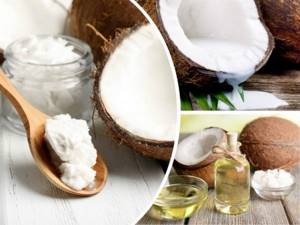
Useful action
The composition of coconut oil is very diverse; its effects on skin and hair have long been used in cosmetology.
It is often used as an intimate oil. Homemade masks for recovery and nutrition help cope with many problems and also perfectly tone the skin.
Using coconut oil for tanning is a justified decision, because the beneficial properties are not limited to cosmetic effects.
Read more about how oil affects the quality of tanning in our article.
Help of coconut oil for tanning:
- Skin hydration, which is very important after sunbathing. Mandatory recommendations for “correct” sun exposure take into account further softening of the skin with moisturizing milk. Coconut oil can also be used in this capacity.
- The processes of melanin production in the deep layers of the dermis are accelerated. This oil has penetrating ability, so it is necessarily used to activate metabolic processes and “deliver” nutrients.
- The protective properties of coconut oil are difficult to overestimate. A thin barrier layer that forms on the surface of the skin helps protect it during prolonged exposure to the sun. This will also protect against photo aging.
- Coconut oil contains fatty acids in large quantities. Under the influence of ultraviolet radiation, they are converted into vitamin D, which ensures a healthy appearance and improves the condition of the dermis.
- Regular use of coconut oil on the skin significantly improves its health, nourishes and smoothes it. In addition, it copes well with stretch marks and some dermatological problems.
The use of coconut oil is quite popular, especially for dry and damaged skin.
In the summer, most girls are faced with the problem of insufficient skin moisture, which inevitably manifests itself in the form of wrinkles and dryness. To eliminate such shortcomings, this product is perfect.
Video about coconut oil for tanning in the sun
In this case, you should first familiarize yourself with the features and contraindications of using the oil.
We invite you to read our article about sun tanning cream with bronzer.
Analogues of drugs in azelaic acid are here.
Video about depilatory cream https://ilcosmetic.ru/uhod-za-telom/depilyatsiya/printsip-raboty-krema.html
When not to use
- Individual intolerance. It is necessary to check the body's reaction before the first use. To do this, apply a small amount to the inside of the elbow. If irritation occurs, do not use the oil.
- Too oily skin. Using it in its pure form is not advisable, as it will only aggravate the problem. It can be added to various formulations or diluted with herbal infusions, but the best option would be to choose a different type of natural oil.
- Tendency to form comedones. The main problem is that clogged skin pores will become even more pronounced after using such products.
- Be sure to cleanse the skin before use. Otherwise, the pores may become clogged and additional dermatological problems will appear.
An undeniable advantage of coconut oil is its hypoallergenicity, because negative reactions have been observed in very rare cases.
This product is also suitable for protecting hair, but use should be carried out in courses no more than once a week.

Rules of application
Read reviews of Garnier spray tanning oil.
Reviews
Milania
Once in the summer I found coconut oil in my cosmetic bag and wondered if it could be used for tanning. After all, other oils can often even be seen in various suntanning products.
I am one of those girls who is very careful not to get sunburned. Without sunblock, my skin just breaks out into blisters. Therefore, I started looking for information on the Internet, communicating about this topic on various forums, and almost everywhere I was told that it was possible to use it for such purposes.
Of course, I trusted the opinion of the majority and decided to test this interesting theory on myself. Before my next trip to the beach, I generously smeared all exposed parts of my body with this product and waited until it was absorbed. I’ll say right away that it obviously won’t make my skin any worse, since it was very soft and velvety.
Therefore, at least as a moisturizer, it will be a great option. But, to my regret, it does not have the same excellent protective properties. There may be some minimal protection, but during aggressive sun conditions it is better to sit in the shade.
Expert commentary. During the hours when the sun is the most aggressive, it is better not to sunbathe at all, even if you have the best and highest quality skin protection. Otherwise you may get very serious burns. I recommend that you read the article about “which tanning oil is best—.”
Karina
I want to share with you my review of coconut oil for tanning in a solarium. I really love sunbathing, and this love doesn't just end with lying on the beach. Even in cold seasons, I always find the time and money to visit the solarium and give my skin a chic caramel shade.
But, of course, I know that you should always take care of protecting your skin, and therefore I always try to purchase only the best and proven products. Previously, I used special tanning creams.
But this time I was offered to buy coconut oil for tanning at the salon. I was very surprised that it could protect my skin at all. The cosmetologist assured me that this was a new technique, and I agreed.
I don’t know about the protection, but the skin became very hydrated, and even after the solarium I felt how soft it was. I think I will continue to use it. I recommend.
Expert commentary. Yes, indeed, coconut oil can simultaneously protect and moisturize the skin while tanning in a solarium. It prevents drying out.
Love
I suggest you read my review of coconut oil for sun tanning. I tried this product on myself for the first time last year. But then I bought a ready-made cosmetic product, which was based on coconut oil. Then I was incredibly pleased, and this year I decided to make the composition myself.
I bought a jar of natural coconut oil and a couple more bottles of other oils. I took a spray bottle and mixed all the ingredients there. If I'm not mistaken, the ingredients included coconut, sea buckthorn and mango oils. Before going to the beach, I smeared myself thoroughly with the mixture and waited until it was absorbed.
I will say right away that it is distributed evenly over the skin, and the mixture is used very sparingly. The shelf life of such a product is no more than a year, and it must be stored exclusively in the refrigerator. Now about the result. I don’t tan when it’s really hot, so I rarely burn. The most interesting thing is that the tan itself turns out to be a very interesting soft caramel shade.
During my entire stay in the sun I only had to apply it twice. I think my mixture did its job perfectly, so I recommend it to everyone.
Expert commentary. A great idea is to mix a few ingredients and make a coconut oil sunscreen.
On this positive note we will end our discussion of this topic. We hope our information was useful and informative for you. Dear readers, would you use this product as sun protection? Or maybe you already had experience? Then write about it in the comments - and we will definitely discuss it!
Author of the publication
Can coconut oil be used for sunburn?

Certainly. Here are the benefits of coconut oil for skin:
- It contains saturated acids (in particular lauric acid), which promote skin healing after sunburn and also reduce inflammation.
- This oil reduces discomfort from flaking and excessive dryness of the skin caused by burns.
- It nourishes and moisturizes the skin.
- It protects against the appearance of wrinkles, creases and stains.
- It is rich in vitamins D and E, as well as protein and other nutrients.
- Thanks to small and medium fatty acids, it is easily absorbed into the skin.
- It contains many antioxidants that protect cells from damage.
- Coconut oil also has antibacterial and antifungal properties, reduces inflammation after a burn, and also stimulates skin regeneration.






